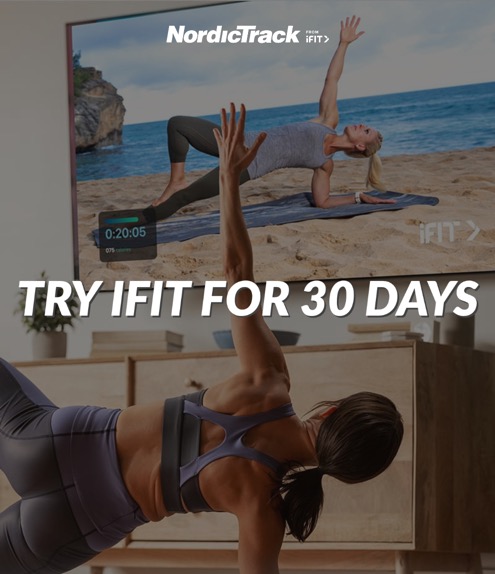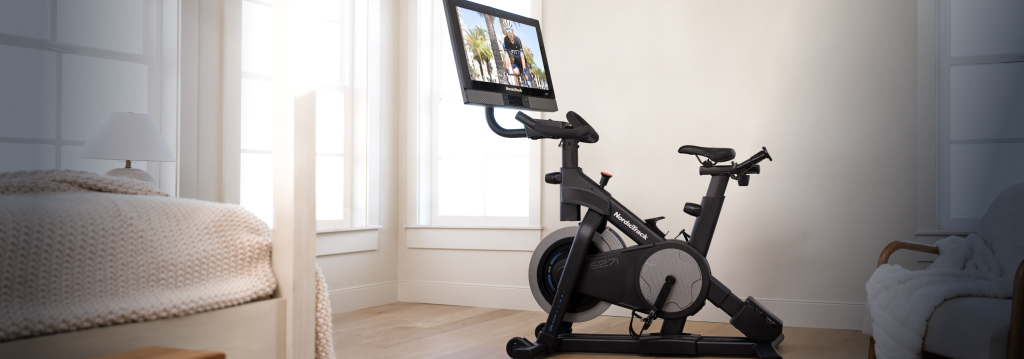
Plenty of health benefits come with using ellipticals and treadmills, but what about exercise bikes?
Does the same hold true for them?
As you’ll soon see in this article, aside from paving the way for you to run faster, there are eight more science-backed exercise bike benefits worth noting.
We’re diving into the research behind those perks, and we’re answering some of the top questions and topics like:
- Is 30 Minutes a Day on an Exercise Bike Enough?
- Can You Get In Shape Just On A Stationary Bike?
- How Long Should You Use An Exercise Bike A Day To Lose Weight?
- Can You Lose Belly Fat By Riding A Stationary Bike?
- Is It Good to Use an Exercise Bike Every Day?
- How to Choose the Right Exercise Bike for You
- How to Adjust Your Bike for Your Height
If you’re short on time, here are some article highlights to check out:
- Exercise bikes can help you torch calories and lose weight
- They’re also an excellent tool for improving heart health
- They’re low-impact, and you can adjust the intensity at any time
Continue reading to see those benefits in-depth, plus answers to the above-mentioned questions.
8 Exercise Bike Benefits, According to Research
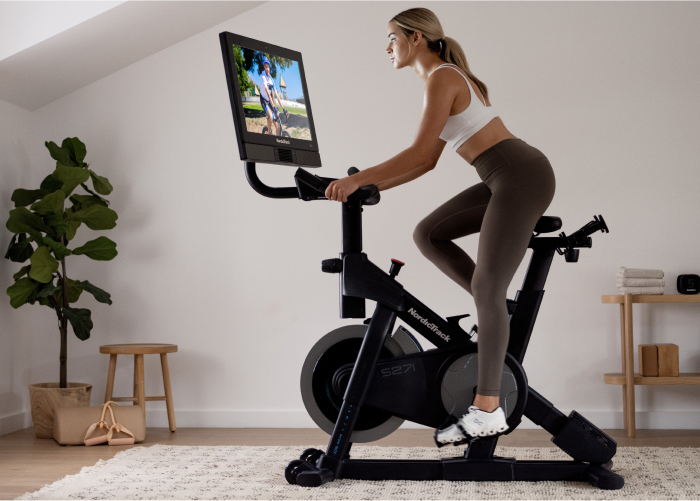
Here are eight great reasons why it pays to start using an exercise bike today:
1. Increased Calorie Burn
One of the best benefits of using an exercise bike is the potential calorie burn.
Like running, indoor cycling uses the large muscle groups in the lower half of your body – including your quadriceps, hamstrings, calves, and glutes.
Because these muscles are so big, when they’re activated, they can potentially burn a significant amount of calories, which may be helpful if weight loss is your goal.
And according to one study, the potential post-exercise calorie burn could last up to 14 hours.
The study examined what happened when ten male subjects completed 45 minutes of vigorous cycling versus taking a rest day (the control group).
Researchers found that the study participants burned an average of over 500 calories, and they noted an additional caloric expenditure of about 190 calories – a 37% increase – on average, 14 hours later. [1]
And, yes, you read that right.
While it’s impressive to see, with only ten male subjects in the study, more research would be needed to confirm these positive effects.
2. Potential for Improved Body Composition, Cholesterol, and Triglyceride Levels
A second study, this time using 40 women, examined what indoor cycling could do for changing body composition and cholesterol and triglyceride levels.
The women were divided into four groups: a control group with no changes, an indoor cycling-only group, a group that used both indoor cycling and a low-calorie diet, and a final group that only went on a low-calorie diet.
The indoor bike portion of the study required people to exercise for 45 minutes per session at three sessions per week for 12 weeks.
As for the low-calorie portion, people were put on a 1,200 kcal diet per day.
Once the study was completed, researchers noted that people in the cycling-only group, cycling plus dietary modifications, and dietary modifications only decreased their BMI (body mass index), total body mass, and fat percentage. [2]
They also mentioned that cholesterol and triglycerides, two measures connected to heart health, also decreased. [2][3]
In the indoor cycling and low-calorie groups specifically, HDL cholesterol, known as the “good” kind, also increased. [2][3]
Similar to the first study, though, with such a small sample size of just 40 people, more research is needed.
However, these studies show a positive relationship between cycling, increased calorie burn, and improved body composition and serum levels, which is great to see.
Harvard Health Publishing of Harvard Medical School posted the average calorie burn of various exercises when people of three different weights engaged in them for 30 minutes.
Regarding indoor cycling, they noted that bicycling at a moderate intensity could burn 210 to 294 calories every 30 minutes, depending on how much you weigh. [4]
Upping the intensity to “vigorous” could yield a 315-441 calorie burn per 30 minutes, depending on how much you weigh. [4]
Double this to an hour, and you could potentially burn anywhere from 420 to 882 calories, which is comparable to running at a moderate pace, using an elliptical, or rowing indoors.
This indicates that indoor cycling could be a comparable alternative to those exercises and a great tool to add to your weekly cardio rotation to keep things interesting and engage your muscles in various ways.
3. Increased Muscle Strength and Stamina
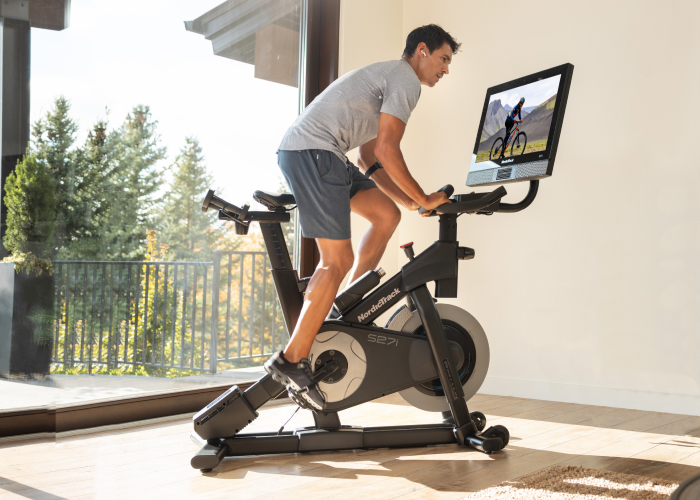
From your quads and hamstrings to your core and glutes, cycling engages various muscle groups, which helps strengthen and tone them.
For studio-style exercise bikes with handles, you can activate your upper body throughout your ride by standing on the pedals instead of sitting the entire time.
This engages your upper body, core, quads, and hamstrings on a deeper level due to the added pressure of holding your entire body upright as you cycle. All of which can help you build muscle and tone your body.
Being able to change your resistance levels throughout your workout also means you can adjust how easy or difficult your rides are.
Upping the resistance can help you increase your muscle and endurance.
4. Improved Cardiovascular Health
Indoor cycling is an excellent aerobic exercise since it gets your heart pumping.
Aerobic exercise also comes with several heart health benefits, according to the Mayo Clinic [5]:
- Decreased risk of heart disease, type 2 diabetes, and stroke
- Improved blood flow throughout the body
- Reduced blood pressure
- Better blood sugar management
- Less arterial build-up
All of those perks add up to improving how strong your heart is and how well it functions, which everyone can benefit from, especially as you age. [5]
On top of that, a very small study of 30 people with metabolic syndrome found significant decreases in blood pressure, cholesterol, triglycerides, and fasting blood sugar levels in the study group that engaged in cycling along with dietary modifications. [6]
As the researchers noted, cycling, along with making dietary modifications, may be helpful in the management of metabolic syndrome. [6]
5. It’s a Low Impact Form of Cardio
Because you’re seated when you use an exercise bike, it’s considered a low-impact form of cardio.
Comparing this to running on the pavement, your feet aren’t striking the hard ground, which means there’s less potential for impact on your knees and joints.
Instead, your feet are firmly planted on the pedals as you push through and cycle.
This creates a smoother resistance that helps strengthen your muscles and joints without subjecting them to abrupt force, making it an excellent form of cardio for anyone looking for low-impact workouts.
6. Decreased Joint Pain
One systematic review of 11 studies with over 700 study participants looked at how cycling affected people with osteoarthritis in their knees.
The researchers found that, compared to study participants who did not engage in any exercise, stationary bike users included in the study reported reduced joint pain and improved performance. [7]
Because of promising data like this, cycling may be a great choice for people with arthritis in the knees.
However, checking with your doctor before engaging in new exercise routines is always best.
7. You Can Change the Intensity at Any Time
Another huge perk of riding an exercise bike is that you can go as hard or as easy as you want.
With a few taps of a button, you can increase or decrease the intensity of your ride to create more or less resistance as you please.
So, on days you’re looking to take a leisurely ride, you can do so, or you can opt to push past your limits just as easily. The choice is yours.
With certain NordicTrack exercise bikes, such as the S27i and S22i, you can even adjust the incline and decline to simulate going uphill and downhill without ever leaving home.
You can also alternate between short bursts of high intensity with slower recovery periods for an at-home HIIT workout.
Maintain or progress your fitness level with one machine.
8. You Can Ride No Matter What the Weather is Outside
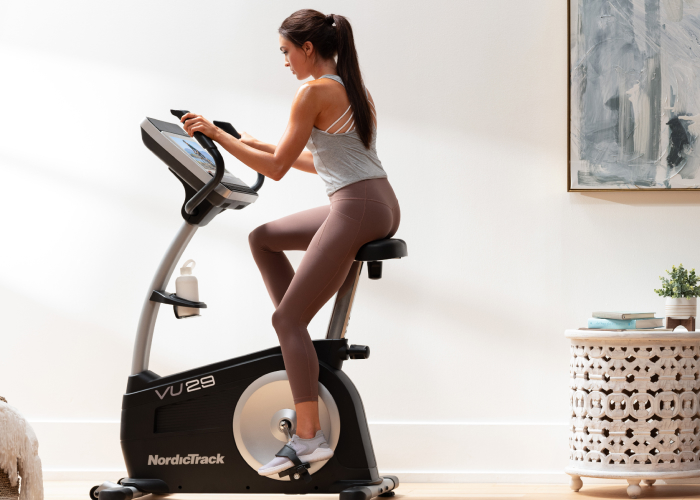
Lastly, even if you love bike riding outdoors, it may not always be an option between cold temperatures, rain, snow, or extremely hot heat waves.
Not to mention, if you work out early in the morning or late at night when it’s dark out, it may be dangerous as cars are quickly commuting past you and may not see you as well.
However, you can safely ride any time of day or night with a stationary exercise bike, and you don’t have to forgo your workout session if the weather is bad, which is another huge perk.
And, if you want to take your indoor rides to the next level, you can travel the world virtually with iFIT workouts, a separate paid subscription service.
iFIT takes you on a personalized fitness journey with expert trainers in the world’s most beautiful locations.
You can ride your bike with iFIT Trainer John Peel in Australia, Jenny Fletcher in scenic Tuscany, Italy, or any other stunning locations in the app.
You can also find off-bike workouts, including pilates, yoga, meditation, stretching, and more. There are also elliptical, rowing, and treadmill workouts if you have any other exercise modalities at home.
To get started with iFIT, visit that link when you’re done here.
Now that you know the benefits of using an exercise bike, you may still have a few lingering questions, such as:
Is 30 Minutes a Day on an Exercise Bike Enough?
The Centers for Disease Control and Prevention currently recommends that people partake in a minimum of 150 minutes of moderate-intensity activity each week combined with two days of strength training. [8]
Applying that standard, you could spend 30 minutes a day on an exercise bike for at least five days out of the week, and it would be enough to meet the CDC’s minimum recommendations to stay active and healthy.
However, as the CDC suggested, it’s also a good idea to pair this with strength training to reap the cardiovascular benefits of cycling and muscle-building perks that come with resistance training.
Adding strength training into your exercise bike routine means you could enjoy the following benefits as you get older, according to the CDC [9]:
- Stronger bones and muscle
- Reduced risk of developing chronic conditions like diabetes, osteoporosis, arthritis, heart disease, obesity, back pain, etc.
- Improved mental and emotional health, including higher self-confidence and decreased depressive symptoms
- Improved sleep
So, while 30 minutes is enough to meet the CDC’s cardio exercise guidelines, you’ll reap even more health perks when you also add in strength training.
Can You Get In Shape Just On A Stationary Bike?
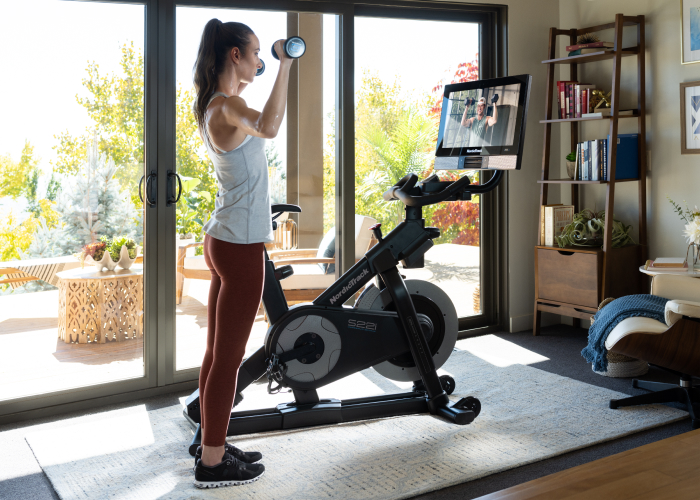
Like any other cardio machine, a stationary exercise bike can be a great tool to get you in shape. But, as we just mentioned, you’ll want to pair this with strength training and dietary modifications for the best outcomes.
For example, if you’re trying to lose weight specifically, you’ll want to start eating in a 300- to 500-calorie-per-day deficit while adding or increasing your exercise and overall movement for the day. [11]
Whether you use an exercise bike, rower, elliptical, or a treadmill, if you’re not eating a 300 to 500-calorie deficit for your height and weight, you likely won’t lose weight. [11]
Adding strength training through lifting weights, using resistance bands, or performing bodyweight exercises can also help change your body composition or reshape your figure.
Post-workout, you also want to ensure you’re eating the right mix of healthy carbs, protein, and fats to promote muscle repair and recovery so you can prepare for your next workout.
These macronutrients are essential for all exercise types, making them an ideal post-workout combination no matter what you’re doing.
That said, using a stationary exercise bike is an excellent option to get in shape and improve cardiovascular fitness. Still, you also want to pair it with strength training and dietary modifications for the best results.
How Long Should You Use An Exercise Bike A Day To Lose Weight?
On top of that question, you may also wonder:
- Will I lose weight if I ride my bike 30 minutes a day?
- How long does it take to see results from a workout bike?
While those are all valid questions, the answers will depend on your unique situation.
If you’re making enough dietary modifications, such as eating healthy and incorporating strength training into your weekly workout routine, you may start to lose weight with the addition of 30 to 45 minutes per day of exercising on a stationary bike for at least five days per week.
However, without all of those puzzle pieces together at once, it will take longer to see true weight loss.
Eating in a slight caloric deficit is the key to losing weight, but it can also lead to losing muscle mass, which is why it’s best to pair dietary modifications with strength training and cardio exercises like riding a stationary bike.
Now, when answering the question, how long does it take to see results from a workout bike? you’ll likely start to notice a difference right away.
During and shortly after your workout, you’ll likely have feel-good endorphins flowing through your bloodstream, similar to experiencing a “runner’s high,” except it’s a “cycling high.”
Exercising on a stationary bike may also improve mood and sleep quality in just a few short sessions.
While the weight loss portion could take some time, that doesn’t mean you won’t see other immediate improvements and positive changes.
If you’re just starting out, shoot for 15 to 20 minutes three to five days out of the week as you work your way up to being able to do 30 to 45 minutes five days per week, and you’ll likely notice and feel a difference right away.
Can You Lose Belly Fat By Riding A Stationary Bike?
The next question that often comes up is: can I lose my belly on an exercise bike?
As mentioned in a previous article on using Treadmill Workouts to Target Abs, combining dietary modifications with exercise is the best way to shed belly fat.
While you can’t spot reduce belly fat with endless amounts of cardio, cardio machines like exercise bikes can help you burn calories, and they’re a useful tool to help you reach your health goals.
But, along with adding cycling workouts into your routine, you’ll want to eat in a slight calorie deficit – somewhere between 300 and 500 calories – and choose whole foods over processed foods as often as possible to reduce belly fat. [11]
You can learn more about those strategies in-depth by visiting that link when you’re done here.
Is It Good to Use an Exercise Bike Every Day?
With any form of exercise, you don’t want to overdo it, or you’ll risk injuring yourself.
And that includes exercise bikes, too.
While it’s a good idea to stay active every day, you may want to take at least one day off a week from biking to give your muscles the proper rest and recovery they need.
On your rest day, you could engage in other low-impact exercises such as taking a slow walk, doing yoga, pilates, or stretching, or taking the day completely off.
Now, if you’re wondering what happens if you ride a stationary bike every day? The answer depends on how hard you’re going.
If you’re casually riding your bike at a leisurely pace every day, it may be okay to ride it daily, although it is best to check with your doctor first.
But, if you’re engaging in high-intensity rides that include faster paces and inclines, it’s best to give your body at least one or two days off to recover and avoid injury.
How to Choose the Right Exercise Bike for You
Now that you know the exercise bike benefits and the answers to commonly asked questions, you may wonder which exercise bike is right for you.
We created an in-depth exercise bike buying guide to help you determine just that. We encourage you to check it out when you’re done here.
As a quick summary, here are the three main types of exercise bikes to consider:
1. Studio-Style Exercise Bikes

Studio-style exercise bikes are designed for high-intensity workouts similar to what you’d see in person in a cycling class.
They have varying resistance levels to help you quickly increase or decrease the intensity, and they position you upright and forward like a traditional outdoor bike.
The NordicTrack S27i and S22i, also feature the ability to incline and decline, which mimics cycling up and down hills and offers a real-world experience.
Whether you’re looking for a studio-style experience or you want it to feel more like real-world terrain without leaving your home, this exercise bike may be right for you.
To learn more about the S27i or S22i, visit those links now.
2. Recumbent Exercise Bikes
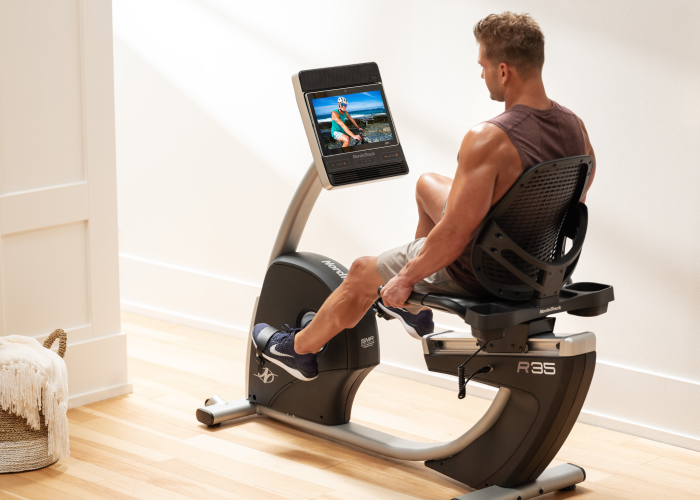
On the other hand, recumbent exercise bikes place users in a seated, reclined position, which offers more back support.
Your legs are also out in front of you in a recumbent bike versus below you like they would be with a studio-style or upright stationary bike.
To learn about the NordicTrack Commercial 35 Recumbent Exercise bike, visit that link now.
3. Upright Stationary Exercise Bikes

Lastly, upright stationary bikes position users vertically, hence the name, and mimic what it’s like to ride beach cruisers or traditional bikes where your back is more upright versus leaning forward.
An upright stationary bike may be perfect for people who want an authentic bike riding experience but don’t need the high intensity of a studio-style bike.
To learn about NordicTrack’s Commercial VU29 Upright Stationary Bike, visit that link now.
You can also learn more about these exercise bikes in-depth and everything else to consider when buying one by visiting our exercise bike buying guide.
Don’t Forget to Adjust the Bike to Your Height
Lastly, no matter which exercise bike you go with, you’ll want to adjust the seat and handlebars to your specific height to ride safely and comfortably.
This ensures that you aren’t placing any tension in the wrong areas, which could lead to injury or low back pain, and that you’re engaging your muscles properly.
To do that, follow these two easy steps:
Step 1: Adjust The Seat Height
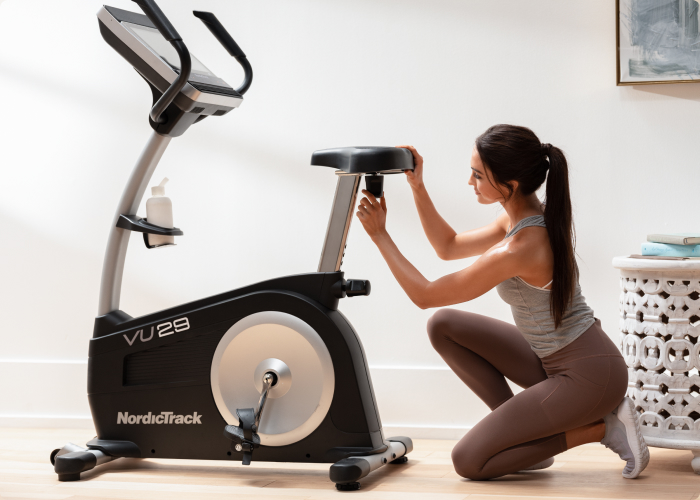
To adjust the bike seat height, stand beside your upright bike with your feet flat on the ground. Adjust the seat to the height of your hip bone.
Your knee should be straight, with your heel pointed down, as you sit in the saddle.
Then, with your foot parallel to the floor, the knee should have a slight bend to it.
Lastly, remain seated and take your feet off the pedals; your toes should touch the ground. [10]
To adjust the seat distance, put your feet on the pedals and position your legs at 9 o’clock and 3 o’clock.
As exercise physiologist Aaron Karp explains, “Imagine there’s a straight line from your front knee right down to the middle of the pedal, which should be right in line with the ball of your foot.” [10]
When adjusting handlebars, it’s best to go with whatever feels most comfortable. Ensure you’re not reaching too far or bunching up your arms because the handlebars are too close. [10]
Step 2: Maintain the Proper Body Position
You should be able to reach the handlebars comfortably (without having to lean forward too far) when riding any stationary exercise bike.
To double-check your position, make sure [10]:
- Your spine is relatively straight
- Your core is engaged
- You have a slight bend in your elbows
- Your knees are tracking over your feet
Following these simple steps will ensure you’re set up for success and safety on your exercise bike.
Reap These Benefits of Exercise Bikes Today
You now know the many science-backed exercise bike benefits and have answers to the most commonly asked questions.
You also know a little more about the different types of exercise bikes and how to position yourself on one properly.
All that’s left to do is find a bike that’s right for you and hop on for your next ride.
You can browse our latest selection of NordicTrack exercise bikes by visiting the links below:
- Studio-Style S27i Exercise Bike
- Studio-Style S22i Exercise Bike
- Commercial 35 Recumbent Exercise Bike
- Commercial VU29 Upright Stationary Bike
And, if you’re just starting out with an exercise bike or getting back into it, be sure to start slowly and work your way up over time.
In just a few short sessions, you’ll be able to feel the difference, and over time, you’ll reap these benefits of exercise bikes.
References
- https://pubmed.ncbi.nlm.nih.gov/21311363/
- https://pubmed.ncbi.nlm.nih.gov/20585735/
- https://www.mayoclinic.org/diseases-conditions/high-blood-cholesterol/in-depth/triglycerides/art-20048186#:~:text=What’s%20the%20difference%20between%20triglycerides,build%20cells%20and%20certain%20hormones.
- https://www.health.harvard.edu/diet-and-weight-loss/calories-burned-in-30-minutes-for-people-of-three-different-weights
- https://www.mayoclinic.org/healthy-lifestyle/fitness/in-depth/aerobic-exercise/art-20045541
- https://pubmed.ncbi.nlm.nih.gov/27364407/
- https://pubmed.ncbi.nlm.nih.gov/33167714/
- https://www.cdc.gov/physicalactivity/basics/adults/index.htm
- https://www.cdc.gov/physicalactivity/downloads/growing_stronger.pdf
- https://www.hss.edu/article_set-up-exercise-bike.asp
- https://medlineplus.gov/ency/patientinstructions/000892.htm
Disclaimer: The primary purpose of this blog post is to inform and entertain. Nothing on the post constitutes or is intended to be a substitute for professional medical advice, prevention, diagnosis, or treatment. Reliance on any information provided on the blog is solely at your own risk. Always seek the advice of your physician or other qualified health provider with any questions you may have regarding a medical condition, and please consult your doctor or other health care provider before making any changes to your diet, sleep methods, daily activity, or fitness routine. Do not disregard professional medical advice or delay seeking it because of information available on this blog. NordicTrack assumes no responsibility for any personal injury or damage sustained by any recommendations, opinions, or advice given in this article. Always follow the safety precautions included in the owner’s manual of your fitness equipment.


